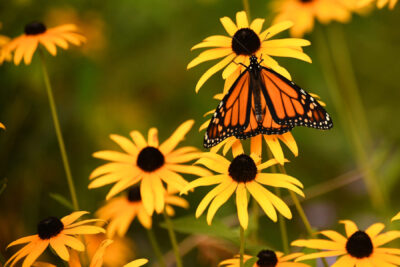
As spring arrives and nature awakens, many of us eagerly anticipate the return of vibrant colors and the gentle hum of bees and fluttering wings of butterflies in our gardens. Beyond their beauty, bees and butterflies play crucial roles as pollinators, supporting the growth of fruits, vegetables, and flowers. At Cold Stream Farm, we believe in fostering environments that support these vital pollinators. Here, we’ll explore some of the best flowers, trees, and shrubs to attract bees and butterflies to your garden.
Flowers
- Lavender (Lavandula spp.): With its fragrant blooms and long flowering period, lavender is a favorite of both bees and butterflies. Plant it in sunny, well-drained areas to attract these pollinators.
- Sunflowers (Helianthus spp.): Sunflowers not only provide a stunning display of color but also offer abundant pollen and nectar for bees and butterflies. Choose varieties with single, open centers, as these are more accessible to pollinators.
- Purple Coneflower (Echinacea purpurea): This native wildflower boasts beautiful purple blooms that attract bees and butterflies throughout the summer months. Its daisy-like flowers are rich in nectar, making them a valuable food source.
- Bee Balm (Monarda spp.): As the name suggests, bee balm is a magnet for bees. Its tubular flowers, available in shades of pink, red, and purple, provide nectar for both bees and butterflies. Plus, its aromatic foliage is deer-resistant.
- Butterfly Bush (Buddleja davidii): True to its name, the butterfly bush is a favorite of butterflies, particularly monarchs and swallowtails. Its fragrant clusters of flowers bloom in various colors, including purple, pink, and white.
Trees
- Flowering Dogwood (Cornus florida): Flowering dogwoods are not only ornamental but also provide early-season nectar for bees and butterflies. Their showy white or pink bracts attract pollinators and add beauty to any landscape.
- Redbud (Cercis canadensis): Redbuds burst into bloom in early spring, producing clusters of small, pinkish-purple flowers along their branches. These flowers are a vital food source for bees emerging from winter hibernation.
- Crabapple (Malus spp.): Crabapples offer both aesthetic value and ecological benefits. Their spring blooms attract bees and butterflies, while their fruits provide food for birds later in the season.
- Willow (Salix spp.): Willows are early bloomers, producing fluffy catkins in early spring. These catkins are an essential source of pollen for bees as they begin foraging after winter.
- Black Cherry (Prunus serotina): Black cherry trees attract a wide range of pollinators with their fragrant, white flowers. Bees, butterflies, and even hummingbirds are drawn to their sweet nectar.
Shrubs
- Viburnum (Viburnum spp.): Viburnums offer attractive blooms and foliage, as well as berries that birds love. Their clusters of small, fragrant flowers attract bees and butterflies in spring.
- Blueberry (Vaccinium spp.): Blueberry bushes not only provide delicious fruit but also support pollinators with their delicate white or pink flowers. Planting a variety of blueberries ensures a prolonged flowering period.
- Spicebush (Lindera benzoin): Spicebush is a native shrub prized for its early spring flowers, which appear before its leaves. These yellow blooms provide valuable nectar for early-emerging bees and butterflies.
- Clethra (Clethra spp.): Clethra, also known as summersweet, produces fragrant, bottlebrush-like flowers in mid to late summer. Their sweet scent attracts bees, butterflies, and other pollinators.
- Honeysuckle (Lonicera spp.): Honeysuckles are beloved for their sweetly scented flowers, which come in a variety of colors. They provide nectar for bees and butterflies throughout the growing season.
By incorporating these flowers, trees, and shrubs into your garden, you can create a haven for bees and butterflies while enhancing the beauty and biodiversity of your landscape. At Cold Stream Farm, we offer a wide selection of plants to help you attract and support pollinators. Let’s work together to create a vibrant and thriving ecosystem in your backyard.
